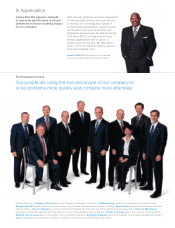Boeing 2011 Annual Report Download - page 17
Download and view the complete annual report
Please find page 17 of the 2011 Boeing annual report below. You can navigate through the pages in the report by either clicking on the pages listed below, or by using the keyword search tool below to find specific information within the annual report.to pay the difference between the original contract price and the cost to re-procure the contract items,
net of the work accepted from the original contract. The U.S. government can also hold us liable for
damages resulting from the default.
Commercial Aircraft. In the United States, our commercial aircraft products are required to comply with
FAA regulations governing production and quality systems, airworthiness and installation approvals,
repair procedures and continuing operational safety. Internationally, similar requirements exist for
airworthiness, installation and operational approvals. These requirements are generally administered
by the national aviation authorities of each country and, in the case of Europe, coordinated by the
European Joint Aviation Authorities.
Environmental. We are subject to various federal, state, local and non-U.S. laws and regulations
relating to environmental protection, including the discharge, treatment, storage, disposal and
remediation of hazardous substances and wastes. We continually assess our compliance status and
management of environmental matters to ensure our operations are in substantial compliance with all
applicable environmental laws and regulations. Operating and maintenance costs associated with
environmental compliance and management of sites are a normal, recurring part of our operations.
These costs often are allowable costs under our contracts with the U.S. government. It is reasonably
possible that continued environmental compliance could have a material impact on our results of
operations, financial condition or cash flows if more stringent clean-up standards are imposed,
additional contamination is discovered and/or clean-up costs are higher than estimated.
A Potentially Responsible Party (PRP) has joint and several liability under existing U.S. environmental
laws. Where we have been designated a PRP by the Environmental Protection Agency or a state
environmental agency, we are potentially liable to the government or third parties for the full cost of
remediating contamination at our facilities or former facilities or at third-party sites. If we were required
to fully fund the remediation of a site, the statutory framework would allow us to pursue rights to
contribution from other PRPs. For additional information relating to environmental contingencies, see
Note 12 to our Consolidated Financial Statements.
International. Our international sales are subject to U.S. and non-U.S. governmental regulations and
procurement policies and practices, including regulations relating to import-export control, investment,
exchange controls and repatriation of earnings. International sales are also subject to varying currency,
political and economic risks.
Raw Materials, Parts, and Subassemblies
We are highly dependent on the availability of essential materials, parts and subassemblies from our
suppliers and subcontractors. The most important raw materials required for our aerospace products
are aluminum (sheet, plate, forgings and extrusions), titanium (sheet, plate, forgings and extrusions)
and composites (including carbon and boron). Although alternative sources generally exist for these
raw materials, qualification of the sources could take one year or more. Many major components and
product equipment items are procured or subcontracted on a sole-source basis with a number of
companies.
Suppliers
We are dependent upon the ability of a large number of suppliers and subcontractors to meet
performance specifications, quality standards and delivery schedules at our anticipated costs. While
we maintain an extensive qualification and performance surveillance system to control risk associated
with such reliance on third parties, failure of suppliers or subcontractors to meet commitments could
5
























